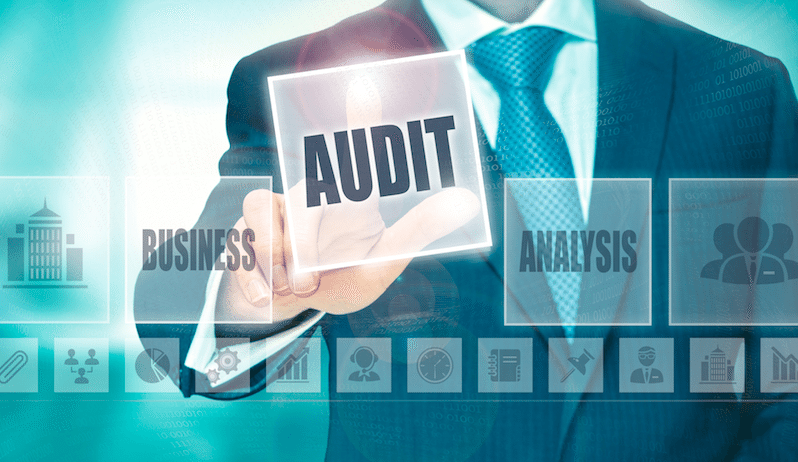
what is an audit?
it is the examination of the financial reports of the business, by an independent person. when examining the financial reports the auditors must follow the auditing standards which are set by the government law.
how is the audit conduct?
the management of the organization prepares the financial statements and the directors agree on this financial report ,then the auditors examine the activities of the organization , take the evidances and then make the judgement on the reports , finally they prepare the audit report out of their opinion Types of audits
Product audit – An examination of a particular product or service (hardware, processed material, software) to evaluate whether it conforms to requirements (that is, specifications, performance standards, and customer requirements).
Process audit – A verification that processes are working within established limits. It evaluates an operation or method against predetermined instructions or standards to measure conformance to these standards and the effectiveness of the instructions. Such an audit may:
Check conformance to defined requirements such as time, accuracy, temperature, pressure, composition, responsiveness, amperage, and component mixture.
Examine the resources (equipment, materials, people) applied to transform the inputs into outputs, the environment, the methods (procedures, instructions) followed, and the measures collected to determine process performance.
Check the adequacy and effectiveness of the process controls established by procedures, work instructions, flowcharts, and training and process specifications.
System audit – An audit conducted on a management system. It can be described as a documented activity performed to verify, by examination and evaluation of objective evidence, that applicable elements of the system are appropriate and effective and have been developed, documented, and implemented in accordance and in conjunction with specified requirements.
A quality management system audit evaluates an existing quality program to determine its conformance to company policies, contract commitments, and regulatory requirements.
Similarly, an environmental system audit examines an environmental management system, a food safety system audit examines a food safety management system, and safety system audits examine the safety management system.
Internal & external audits: first-, second-, and third-party audits
A first-party audit is performed within an organization to measure its strengths and weaknesses against its own procedures or methods and/or against external standards adopted by (voluntary) or imposed on (mandatory) the organization. A first-party audit is an internal audit conducted by auditors who are employed by the organization being audited but who have no vested interest in the audit results of the area being audited.
A second-party audit is an external audit performed on a supplier by a customer or by a contracted organization on behalf of a customer. A contract is in place, and the goods or services are being, or will be, delivered. Second-party audits are subject to the rules of contract law, as they are providing contractual direction from the customer to the supplier. Second-party audits tend to be more formal than first-party audits because audit results could influence the customer’s purchasing decisions.
A third-party audit is performed by an audit organization independent of the customer-supplier relationship and is free of any conflict of interest. Independence of the audit organization is a key component of a third-party audit. Third-party audits may result in certification, registration, recognition, an award, license approval, a citation, a fine, or a penalty issued by the third-party organization or an interested party.
Purposes of audits
An auditor may specialize in types of audits based on the audit purpose, such as to verify compliance, conformance, or performance. Some audits have special administrative purposes such as auditing documents, risk, or performance or following up on completed corrective actions.
Certification
Companies in certain high-risk categories—such as toys, pressure vessels, elevators, gas appliances, and electrical and medical devices—wanting to do business in Europe must comply with Conformité Europeënne Mark (CE Mark) requirements. One way for organizations to comply is to have their management system certified by a third-party audit organization to management system requirement criteria (such as ISO 9001).
Customers may suggest or require that their suppliers conform to ISO 9001, ISO 14001, or safety criteria, and federal regulations and requirements may also apply. A third-party audit normally results in the issuance of a certificate stating that the auditee organization management system complies with the requirements of a pertinent standard or regulation.
Third-party audits for system certification should be performed by organizations that have been evaluated and accredited by an established accreditation board, such as the ANSI-ASQ National Accreditation Board (ANAB).
Performance versus compliance/conformance audits
Various authors use the following terms to describe an audit purpose beyond compliance and conformance: value-added assessments, management audits, added value auditing, and continual improvement assessment. The purpose of these audits goes beyond traditional compliance and conformance audits. The audit purpose relates to organization performance. Audits that determine compliance and conformance are not focused on good or poor performance. Yet performance is an important concern for most organizations.
A key difference between compliance/conformance audits and audits designed to promote improvement is the collection of audit evidence related to organization performance versus evidence to verify conformance or compliance to a standard or procedure. An organization may conform to its procedures for taking orders, but if every order is subsequently changed two or three times, management may have cause for concern and want to rectify the inefficiency.
Follow-up audit
A product, process, or system audit may have findings that require correction and corrective action. Since most corrective actions cannot be performed at the time of the audit, the audit program manager may require a follow-up audit to verify that corrections were made and corrective actions were taken. Due to the high cost of a single-purpose follow-up audit, it is normally combined with the next scheduled audit of the area. However, this decision should be based on the importance and risk of the finding.
An organization may also conduct follow-up audits to verify preventive actions were taken as a result of performance issues that may be reported as opportunities for improvement. Other times organizations may forward identified performance issues to management for follow-up
at the end , we have professional leaders at the audit services , we will help your organization to avoid the frauds in the business ,shape your organization's future.











